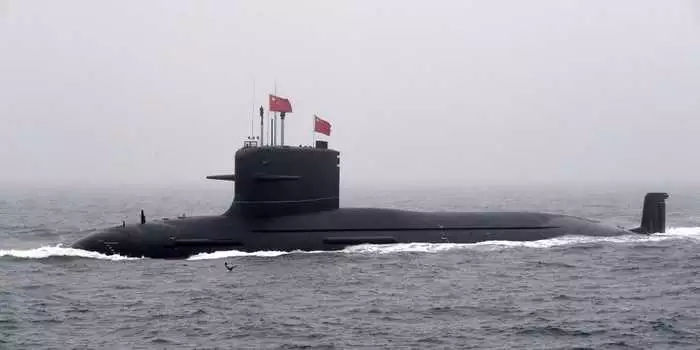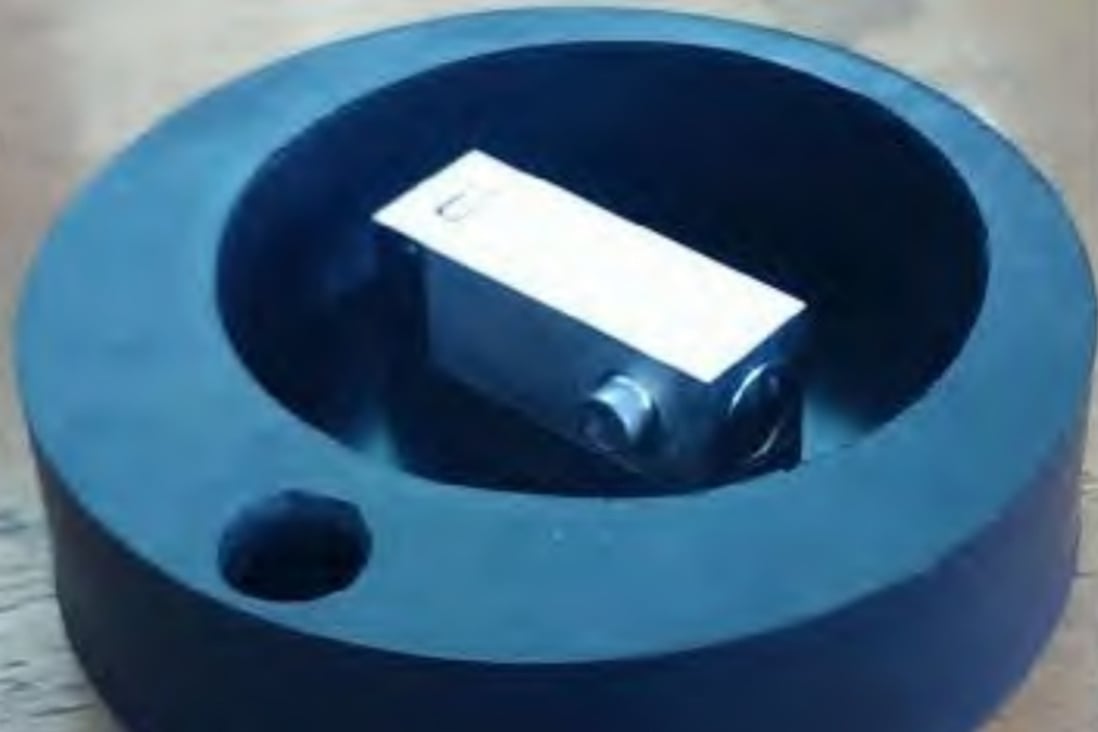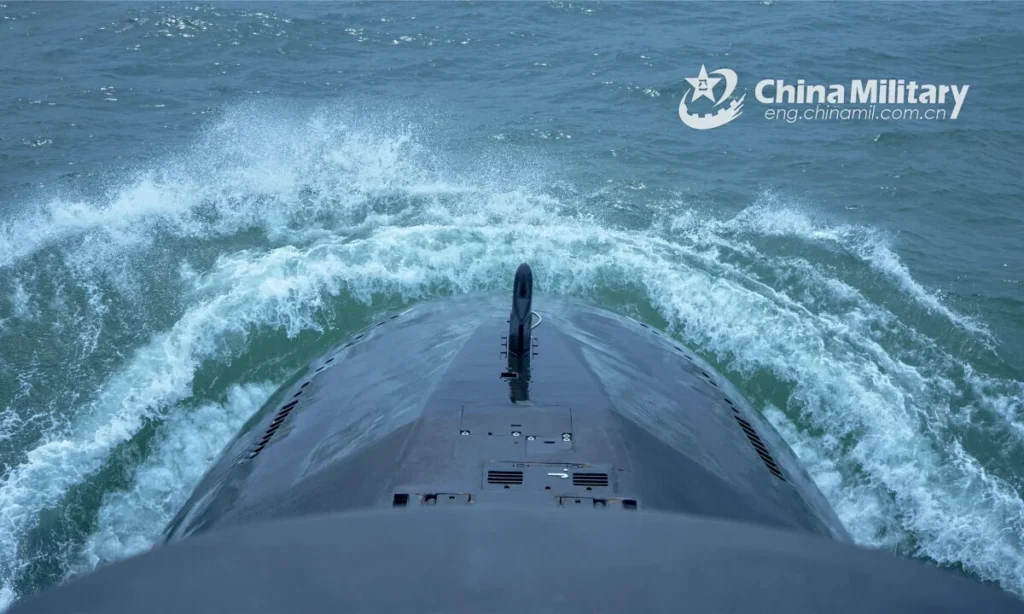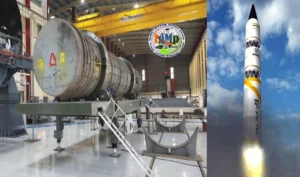Source : The EurAsian Times

China develops new Stealth Technology for its submarines that can dodge US Navy sonars by mimicking water
Chinese researchers claim to have developed a novel coating device that could help submarines dodge sophisticated enemy sonar by resembling water.
Submarines around the world, including nuclear subs, have been playing hide-and-seek with the newest anti-submarine warfare capabilities for years. The advancement in technology has given way to the development of cutting-edge tools that would help navies locate hostile submarines.
The development of the latest Chinese technology appears to reverse that and escape unscathed. In order to locate hostile submarines, active sonar is used whereby the submarine transmits a sound pulse and calculates the time it takes to reach the target and be reflected back.
According to Chinese researchers, the tile-shaped device developed by them can analyze an enemy’s sonar frequency and produce opposing sound waves so that the sonar operator will mistake the submarine for water, Hong Kong-based South China Morning Post reported.
The Beijing Institute of Technology team claims that the low-frequency noises produced by the tiles have an intensity of up to 147 decibels, which is louder than a rock concert and strong enough to block out some of the most potent active sonars used by the US military or its allies.

Further, Chinese engineers can stick the device all over the hull of a submarine to deal with sonar beams coming from various angles because a complete unit is less than half the size and thickness of a brick.
This development comes at a time of great power competition unfolding between China and its western adversaries, particularly the United States. Although the US mainly operates nuclear-powered submarines, the PLA Navy has continued to use its conventionally powered submarines while leapfrogging on building nuclear-powered vessels that are more efficient.
At the root of all submarine operations is ‘secrecy.’ The geography of China, which is surrounded by shallow waters and requires passing through choke points before reaching the deep waters of the Pacific, presents the biggest challenge to submarine operations. It is much easier for the US to conduct submarine ops.
On its part, China has been making concerted efforts to bolster its submarine fleet with a focus on lowering (or essentially eliminating) detectability by the United States Navy and its regional allies, especially in the Pacific. For instance, the Type-039C sub is believed to be totally undetectable and has the kind of stealth contouring used in stealth aircraft, as previously noted by The National Interest.
The #Chinese Navy’s newest submarine, the one with the angled sail, is already been commissioned into service.
It is stationed in the East Sea Fleet, making it directly relevant to the #Taiwan situation#OSINThttps://t.co/AlGsFy5lUG
— H I Sutton (@CovertShores) August 11, 2022
More pertinently, there were reports in August 2022 that the PLA Navy had stationed this latest attack submarine in its East Sea Fleet. For perspective, the East Sea Fleet submarine sites are located roughly 500 kilometers (310 miles) south of the main Taiwanese Island. It also contends with the network of islands that make up Japan, which serves as a natural barrier between the open Ocean.
Not just that, China’s naval presence, including its conventional and nuclear submarine operations, has vastly expanded in the Indo-Pacific region. This has been a primary reason behind the Australian decision to sign the AUKUS deal for purchasing Virginia-class nuke submarines from the United States, with design assistance from the United Kingdom.
Against the backdrop of towering Chinese efforts at submarine development and bolstering the stealth component of these submarines, the newly claimed Chinese innovation becomes all the more significant and intriguing.
China’s New Tile Innovation Will Make Its Subs Undetectable
“The submarine surface coating widely used by the world’s naval powers is the anechoic tile,” the researchers said in their paper published in Chinese-language peer-reviewed journal Acta Armamentarii last month.
These “passive” sound-absorbing tiles, typically less than 7 centimeters (2.8 inches) thick and made of rubber or synthetic polymer, are most effective against sonar signals in the higher frequency range with wavelengths shorter than their thickness.
However, because the two are inversely proportional, they could not be as efficient against longer wavelengths and hence lower frequencies.
Lead researcher Wang Wenjie and his colleagues said in their paper, “The frequency of modern active sonars is getting lower and lower, with wavelengths exceeding one meter. The passive coating can no longer meet the combat requirements of a quiet submarine, no matter how you change the material composition and structure of the tiles.”
According to the report, the “active” tile created by the Beijing Institute team is based on a technology known as giant magnetostrictive material (GMM), which was named after a phenomenon identified by British physicist James Joule in the 19th century.

The paper notes that the phenomenon known as “magnetostriction”—in which some materials stretch or contract when brought close to a magnet—was originally noticed by Joule in 1842.
Since the magnet-induced changes were too modest for any significant applications, the discovery was dismissed for more than a century as being both interesting and pointless.
The US Navy’s scientists created the Terfenol-D alloy in the 1970s, the first GMM capable of transforming magnetic force into mechanical energy and causing observable shape changes. Terfenol-D is employed in important driving components for active sonars on several US warships due to its high-power output and efficiency, according to Wang’s research.
However, because GMM manufacture requires a significant amount of expensive and heavy Rare Earth elements, such as Terbium and Dysprosium, whose reserves are primarily concentrated in China, the technology’s use is still limited.
Wang and his colleagues contend that the active sonar technology used by the US might be turned against itself. It was difficult to cram all the parts into a small space while still producing a lot of power. The researchers claimed that earlier active acoustic stealth prototypes were tens of times larger than China’s.
Further, according to the researchers, the engineering design of the device was also greatly improved by the researchers to make it ideal for speedy installation, long-term use, and maintenance on submarines in deep oceans.
“The emission unit is lightweight, operable in a wide range of frequencies with high efficiency, and resistant to pressure,” the paper said.
The method would find broad applicability in the cladding of active acoustic arrays on large-scale submarines, according to the scientists, who refused to divulge the price or rare earth composition of the enormous magnetostrictive components of the system.
Commander Ashok Bajalwan, a former Indian Navy submariner, told EurAsian Times – Technically, active noise cancellation is used widely, including in aircraft, for human comfort by generating/emitting a sound of the same amplitude but opposite in phase which cancels the incoming sound (even anechoic tiles, due to their porous structure, create a phase difference between the incident and reflected sound waves that are difficult to recognize by the emitter sonar).
Also, the active cancellation is uni-directional and not omni-directional. You must choose the direction in which you want to transmit the sound waves. Also, the sound waves from a sonar would come to a submarine from different directions, as sound does not travel in a straight line underwater. Under such circumstances, it will be difficult for the “tile” to emit the canceling sound waves in all those directions.
Considering the above and my limited knowledge on the latest innovation, I think this concept is difficult to put to practical use. Having said that, it is probable that it may work when the active sonar is operating in close proximity to the submarine, in which case the incident sound wave will be in a nearly straight line, Bajalwan concluded.






